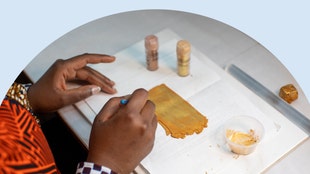Friendly disclaimer: If you list products for sale on Etsy, you must comply with all Etsy policies and legal requirements applicable to those products and product listings, including those in your jurisdiction and those to which you sell. This information provides a non-exhaustive overview regarding key legal requirements, in major Etsy markets, for educational purposes only, is subject to change over time, and is not legal advice. It's not intended to create, and receipt of it does not constitute, a lawyer-client relationship. The authors, Etsy, Inc. and Etsy Ireland UC disclaim all responsibility for any and all losses, damages, or causes of action that may arise or be connected with the use of or reliance on these materials. Please consult a licensed lawyer in your area for legal assistance.
Etsy believes in the power of handmade. Together, we believe that handmade should mean well-made, too.
Etsy values product safety and the safety of the Etsy community. As outlined in our Terms of Use, Etsy sellers must follow all applicable laws and regulations, including government safety requirements in their products’ destination country as well as their own jurisdiction. However, sellers should understand that even products that are fully compliant with safety requirements can still have design and manufacturing issues that could lead to safety problems. In short, just compliance with laws doesn’t always equal safety. The two ideas are both important and each requires different strategies.
Jump to product safety education by topic
When it comes to manufacturing articles of the highest craftsmanship, sellers should seek to continuously improve the design and manufacturing of their products. Just because a product is handmade with love, that doesn’t mean that the product is necessarily safe enough for sale to the general public. A high-quality product requires thoughtful design, careful engineering, and, often, multiple efforts at prototyping to ensure that only the highest quality finished product is provided to buyers. Consider the following guidelines:
1. Design for safety
Be thoughtful of the potential hazards of your product. When considering hazards, consider not only how the product may be used, but also how it may be misused.*
While each individual country’s laws may be different, the approach to safety is generally the same—you should design for safety. As an example, the main U.S. product safety regulator, the US Consumer Product Safety Commission (CPSC)’s best practices guidance, available here, describes a “safety hierarchy,” which teaches that the safest approach to eliminating risk is to redesign the product to remove the hazard. If redesigning is not feasible, then the next best approach is a guard or barrier to separate the user from the hazard. And if a guard is not feasible, then use a warning.
Someone who is independent can question your assumptions. Sometimes a product may be new, innovative, and fill a need. However, sometimes a product may not be in the market already for a reason—it may be a bad idea or it may be banned. Others may have considered it and recognized that it could potentially lead to an injury. When manufacturing products (especially new product ideas) for children under 3 years of age, an independent assessment should be considered a critical step.
CPSC’s Handbook for Manufacturing Safer Consumer Products contains guidance and best practices. You can find UK guidance for producers here. Australian guidance can be found here. You should also search to see if products like the ones you are planning to make have been recalled or raised safety concerns. You can use keywords to search US recalls and reports of harm for products similar to the one that you are manufacturing at SaferProducts.gov. Recall announcements in the EU can be found here. UK recalls announcements are found here. For Australian recall announcements please check here. Additionally, the Organization for Economic Co-Operation and Development (OECD) maintains a portal of recalls in multiple countries.
Industry voluntary consensus standards provide applicable design requirements and recommendations. These are very useful standards made by industry groups, government agencies, and consumer groups who together agree on best consumer product safety practices. Reviewing these standards provides a wealth of information. There are thousands of available standards, many available for a nominal fee, which can provide you with the considered expertise of experts in the field. If a standard doesn’t exist yet for your product, you may still be able to review related standards to find ideas and recommended best practices. Most U.S. consumer and children’s products standards are developed by ASTM International in its Consumer Products Committee. International standards setting organizations include ISO, the British Standards Institute (BSI), Standards Australia, and the CSA Group.
2. Redundancies in design and manufacturing
Design and manufacture your product with redundancies wherever possible. A redundancy is a duplication of a critical component or function. A redundancy may be needed once you or a third party analyzes your product for potential critical failures.
One such potential failures are identified, a seller should redesign the element to protect it from failure. For example, could a different shape be less likely to fail? Can a specific part be designed with a two-step process to twist and lock it into place? Or, if you are planning to glue or epoxy a component, can you also add a fastener like a screw in case the glue fails?
3. Quality and consistency
In many ways, handmade can offer sellers an incredible opportunity to physically review each product, something that a mass manufacturing model may not. This presents an opportunity to ensure a consistent high-quality product, but can also lead to inconsistency.
Have you considered different designs and manufacturing concepts when designing your original product? Have you made multiple prototypes? For example, have you examined the strength and consistency of different variables? Modern manufacturers may test various prototypes to find the ideal dimensions for ideal performance, the ideal type and amount of glue or epoxy, cure times for strength, or the appropriate fastener size and material. Thoughtfully designing and prototyping allows you to set a standard to measure your future production against.
4. Specifications
Once you have identified the ideal characteristics of your product, document your processes. Doing so helps you clearly outline each step of your work and the component parts needed. It also allows you to show to yourself and to others (if needed) the diligence and care you have put into designing and manufacturing your products.
Ensuring that all your component parts are consistently and carefully selected for safety and compliance (especially for children’s products) is critical. Strongly consider your supplier’s reputation and track record. Buying components from unknown foreign manufacturers may offer cost-savings but may also come with increased risks. Continue to take care as manufacturing proceeds that there have been no changes in what parts you use. If you are manufacturing children’s products, familiarize yourself with ongoing testing requirements, such as the CPSC’s requirements on material change testing, periodic testing, and component part testing.
* The U.S. government and the law will expect you to consider misuse of a product, provided that it could be considered foreseeable. For example, the CPSC considered it to be foreseeable for consumers to transfer a sleeping baby in a floor napper to the inside of a crib so as not to wake the baby; in that case, six babies died. See CPSC announcement of settlement here.
Product safety education by topic
United States
California Proposition 65 Warnings
Small Parts in Children’s Toys
Plants, Seeds, Bulbs or Soil Products
Requirements for Lead and Lead in Paint
Europe
Selling Consumer Products in Europe under the General Product Safety Directive (GPSD)
Selling Cosmetic Products in Europe
Selling Electronic Products in Europe
 Words by Etsy Staff
Words by Etsy Staff




